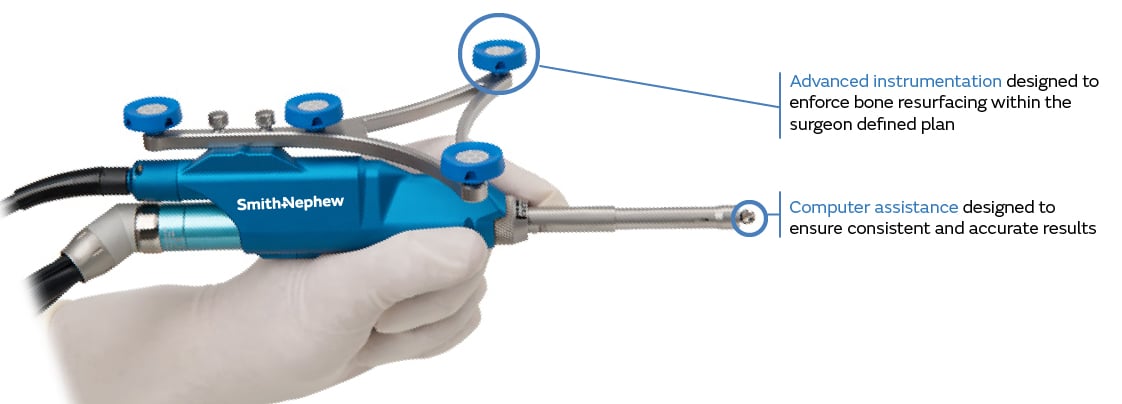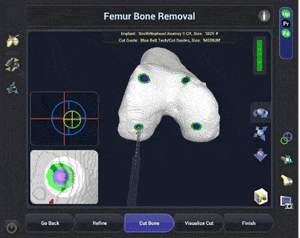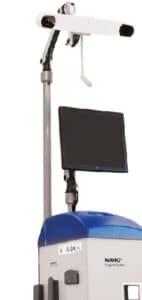NAVIO Total Knee Replacement Surgery
The NAVIO Surgical System is designed to help tailor your total knee replacement surgery to the unique shape and motion of your knee.
Total Knee Replacement with Your Anatomy in Mind
More than 600,000 total knee replacement procedures are performed each year in the U.S. and more than 90% of these patients experience a dramatic relief in knee pain and are better able to perform common activites.1 The NAVIO Surgical System delivers robotics-assisted tools designed to help tailor your total knee replacement surgery to the unique shape and motion of your knee.
Need to Schedule an Appointment?
Give us a call or submit our contact form to request an appointment with one of our skilled physicians.
Contact UsRobotics-assisted knee replacement planning with the NAVIO System
The total knee replacement procedure starts with your unique anatomy in mind. By the time your procedure is complete, the damaged bones and cartilage within your knee joint will be removed and replaced with new implant components. Each of these implant components must fit precisely and be aligned to your natural anatomy if they are to provide you with the best outcome possible. The challenge of aligning your implant and preparing your bones to accept it can be complex, invasive and time-consuming because no two knee joints are exactly the same.

The NAVIO Surgical System is designed to help your surgeon not only plan your surgery based on your unique anatomy, but also position your total knee implant using a combination of computer and robotic assistance. The NAVIO procedure starts with an advanced computer system that gathers precise anatomic and alignment information about your joint that your surgeon will use to create your specific surgical plan.
This extra layer of data collection and planning is designed to help ensure your knee procedure is performed exactly as your surgeon intends and that your implant is positioned as accurately as possible for the best long-term outcome.
CT-free

The NAVIO system eliminates the need for CT scans by using an advanced computer program to collect anatomic and alignment information about your knee. Once captured, this information is used to build a precise, computer-rendered 3D model of your knee that your surgeon will use to plan your surgery.
Total knee replacement surgery without rods

Because the NAVIO system has already gathered the anatomic alignment information about your knee, it eliminates the need for IM rods. Instead, your surgeon will use the system's handheld robotics-assisted tool (the NAVIO handpiece) to accurately position the NAVIO-specific cut guides which are held in place with a few small pins instead of the IM rod. This process leaves the central canal of your bone untouched. Implant alignment is a crucial factor in determining how long the implant will last 3, 4.
NAVIO brings robotics-assisted precision to total knee surgery
After removing the cutting guides, the prosthetic knee implants are implanted and your knee is checked to make sure it moves and is balanced correctly. It is important to understand that the NAVIO system doesn't replace your surgeon. The procedure remains in the skilled hands of your surgeon, with the NAVIO system providing extra layers of planning, accuracy and precision.
Important safety notes
Individual results of joint replacement vary. Implants are intended to relieve knee pain and improve function, but may not produce the same feel or function as your original knee. There are potential risks with knee replacement surgery such as loosening, wear and infection that may result in the need for additional surgery. Patients should not perform high impact activities such as running and jumping unless their surgeon tells them that the bone has healed and these activities are acceptable. Early device failure, breakage or loosening may occur if a surgeon's limitations on activity level are not followed.
Disclaimer
Individual results may vary. There are risks associated with any surgical procedure including NAVIO-enabled Knee Replacement. NAVIO is not for everyone. Children, pregnant women, patients who have mental or neuromuscular disorders that do not allow control of the knee joint, and morbidly obese patients should not undergo a NAVIO procedure. Consult your physician for details to determine if NAVIO is right for you.
References
- American Academy of Orthopaedic Surgeon website, accessed March 7, 2017 //orthoinfo.aaos.org/topic.cfm?topic=A00389
- Ponzio DY, Lonner JH, Preoperative Mapping in Unicompartmental Knee Arthroplasty Using Computed Tomography Scans Is Associated with Radiation Exposure a..., J Arthroplasty (2014)
- Collier, Matthew, et al., "Patient, Implant, and Alignment Factors Associated With Revision of Medial Compartment Unicondylar Arthroplasty.", Jour of Arthro, Vol 21 No 6, Suppl. 2, 2006.
- Hernigou, Ph, Deschamps, G., "Alignment Influences Wear in the Knee after Medial Unicompartmental Arthroplasty.", Clin Orthop Relat Res., Volume 423, June 2004, pp 161-165
All information provided on this website is for information purposes only. Every patient's case is unique and each patient should follow his or her doctor's specific instructions. Please discuss nutrition, medication and treatment options with your doctor to make sure you are getting the proper care for your particular situation. If you are seeking this information in an emergency situation, please call 911 and seek emergency help.
All materials copyright © 2020 Smith & Nephew, All Rights Reserved.
From Our Blog
News, tips and resources




